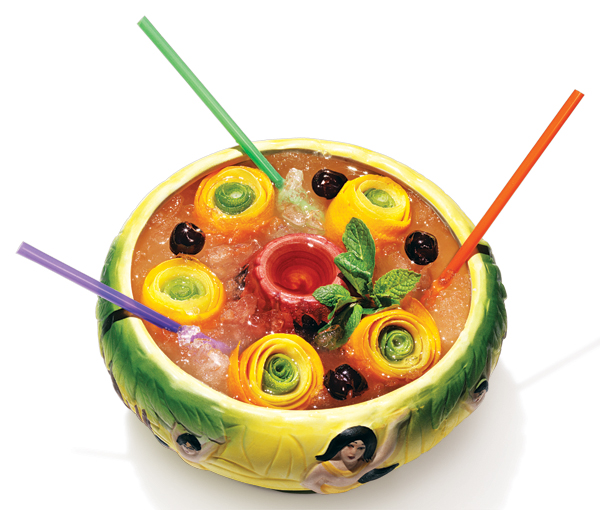Good Libations
 Photo by Bruce Peterson. Styling by Monica Mariano/Ennis.
Photo by Bruce Peterson. Styling by Monica Mariano/Ennis.
What goes better with crab rangoons and barbecue ribs than a flowery vat of fruit juice and booze? We grabbed a footlong straw and set out to field-test the scorpion bowls at some of the most popular spots in town.
HONG KONG
Faneuil Hall
$16.75 for two
The Blend: Maraschino cherries, orange slices, and a lethal swirl of spirits that the Hong Kong won’t reveal.
The Buzz: A few sips of this cloying tropical medley guarantees a sugar-induced headache.
GOLDEN TEMPLE
Brookline
$23.75 for two
The Blend:Light rum, dark rum, fruit juice, and brandy upon request.
The Buzz:The pale yellow nectar is a dead ringer for margarita mix laced with Hi-C Ecto-Cooler.
DRINK
Fort Point
$13 per person
The Blend: Citadelle gin, Pierre Ferrand cognac, and Smith & Cross Jamaican rum.
The Buzz: This version—based on Steve Crane’s Luau recipe—is one part classy cocktail, two parts Polynesian kitsch.
MYERS + CHANG
South End
$16 for two
The Blend: Coconut rum, pineapple rum, Patrón Citrónge, cranberry juice, and orange juice.
The Buzz: Vintage glassware, piles of fruit, and a handful of maraschinos deliver a pleasant scorpion sting.
MYUNG DONG 1ST AVE
Allston
$28 for four
The Blend: Soju (a sweet rice liquor) and honeydew pulp.
The Buzz: This Korean take on the classic bowl is a crowd-pleasing elixir (and a deceptively powerful one at that).
The Rice Stuff
Sake, the Japanese spirit crafted from rice, pairs well with everything from sashimi to pizza. Three types of premium sake are categorized by the amount of rice milled away during production, with the most delicate variety having the least amount of grain. We asked Alyssa DiPasquale, the general manager at O Ya, to tell us about all three.
Tip: If the writing on the sake bottle is in Japanese, look for the milling percentage of the sake you like.
JUNMAI
Tasting Notes: The least milled of the premium sake varieties, this beverage is full-bodied and rich, with hints of earthy truffle and plenty of umami.
Try If You Like: Pinot noir, merlot, cabernet, or syrah.
JUNMAI GINJO
Tasting Notes: A less robust variety, with a range of fruit flavors and floral notes.
Try If You Like: Chardonnay, riesling, or pinot noir.
JUNMAI DAIGINJO
Tasting Notes: The most-milled version, this sake boasts the most delicate, clean flavor of the three.
Try If You Like: Pinot gris, dry rieslings, or sauvignon blanc.
 While Junmai has been traditionally milled to 70%, there is no longer a minimum milling requirement.
While Junmai has been traditionally milled to 70%, there is no longer a minimum milling requirement.
Better Your Beer
These authentic brews complement everything from stir-fries to fiery seafood.
DOGFISH HEAD CHATEAU JIAHU
Delaware
Based on a 9,000-year-old fermented beverage discovered in pottery from the Stone Age village of Jiahu, in northern China, this fruity, slightly sweet beer combines barley with orange-blossom honey, muscat grapes, brown-rice syrup, and hawthorn berries.
Try It With: Spicy Szechuan fare like jin gu fish or Chongqing chicken.
HITACHINO NEST WHITE ALE
Japan
Hitachino produces Japan’s best-known craft beer, and this Belgian wheat variety, infused with coriander, nutmeg, and orange peel, is its signature blend. The bright, creamy lemon-meringue notes complement both ginger and broccoli.
Try It With: Tempura vegetables or fried pork dumplings.
ROGUE MORIMOTO SOBA ALE
Oregon
This lager, a collaboration between Oregon’s Rogue Ales and Iron Chef Masaharu Morimoto, uses soba (also known as buckwheat) as the malt base. The combination of toasted walnut and grapefruit notes makes it a good accompaniment to rich starches.
Try It With: Scallion pancakes and dan-dan noodles.
HITACHINO NEST ESPRESSO STOUT
Japan
You don’t immediately think of heavy stouts with Asian cuisine, but the lush notes of caramel, vanilla, and fudge in this brew really stand up next to rich, sauced meats.
Try It With: Char siu (Chinese barbecue pork) and Peking duck.
For more on Asian cuisine in Boston, check out our complete guide to Asian cuisine: Umami Rising.
Correction, 02/06/2013, 3:41 p.m.: In the print and original online versions of this story, we wrote, “The three types of premium sake are categorized by the amount of rice milled away during production.” This implies that there are only three types of premium sake, which is incorrect. The sentence should have begun without the definite article. We also stated that Junmai sake rice is milled to 70% or less of the original grain. In fact, while Junmai sake rice has traditionally been milled to this percentage, there is no longer a minimum milling requirement. All sake labeled as a “junmai” sake, however, must still list the percentage of milling on the bottle. The online version of this story has been updated to reflect these corrections.